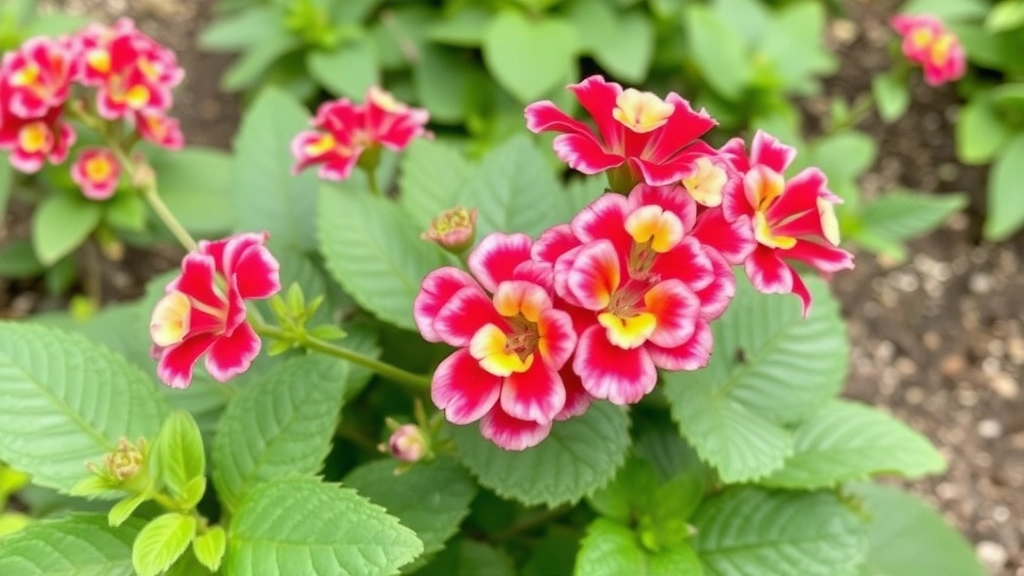Deadheading Kalanchoe Flowers
Deadheading Kalanchoe flowers is essential for keeping your plant vibrant and encouraging continuous blooming. By removing faded or dead blooms, you not only enhance the plant’s appearance but also promote healthier growth. In this guide, I’ll walk you through the process of deadheading Kalanchoe flowers to ensure your plant remains in top condition.
Steps for Deadheading Kalanchoe
- Identify Spent Blooms: Start by identifying spent blooms that need removal.
- Use Clean Tools: Use clean, sharp pruning shears to make precise cuts, ensuring you don’t damage the plant.
- Timing: Timing is crucial; deadhead during the blooming cycle for the best results.
- Provide Proper Care: After deadheading, provide proper care with adequate watering, fertilizing, and lighting to support new growth.
With these tips, your Kalanchoe will thrive and continue to bloom beautifully.
Identifying Spent Kalanchoe Blooms
Have you ever looked at your Kalanchoe and wondered if it’s time to deadhead? Recognising spent blooms is crucial for maintaining the health and vibrancy of your plant.
Signs of Spent Blooms:
- Faded Colour: Fresh Kalanchoe flowers are vibrant. If you notice a dull or faded hue, it’s likely time to remove them.
- Wilting Petals: When petals start to droop or wilt, they are past their prime and should be deadheaded.
- Brown Edges: Brown or crispy edges on the flowers indicate that they have completed their life cycle.
- Seed Formation: If you see seed pods developing, it’s a sure sign that the flowers are spent.
Why Identification Matters:
Identifying spent blooms not only enhances the aesthetic appeal of your Kalanchoe but also encourages new growth. By removing these faded flowers, you redirect the plant’s energy to produce fresh blooms rather than expend resources on dying flowers.
For more tips on keeping your Kalanchoe vibrant, check out our care tips for vibrant red florist Kalanchoe blooms. Additionally, if you’re interested in learning how to make your Kalanchoe bloom all summer, visit our expert tips on summer blooming.
Tools Needed for Deadheading Kalanchoe
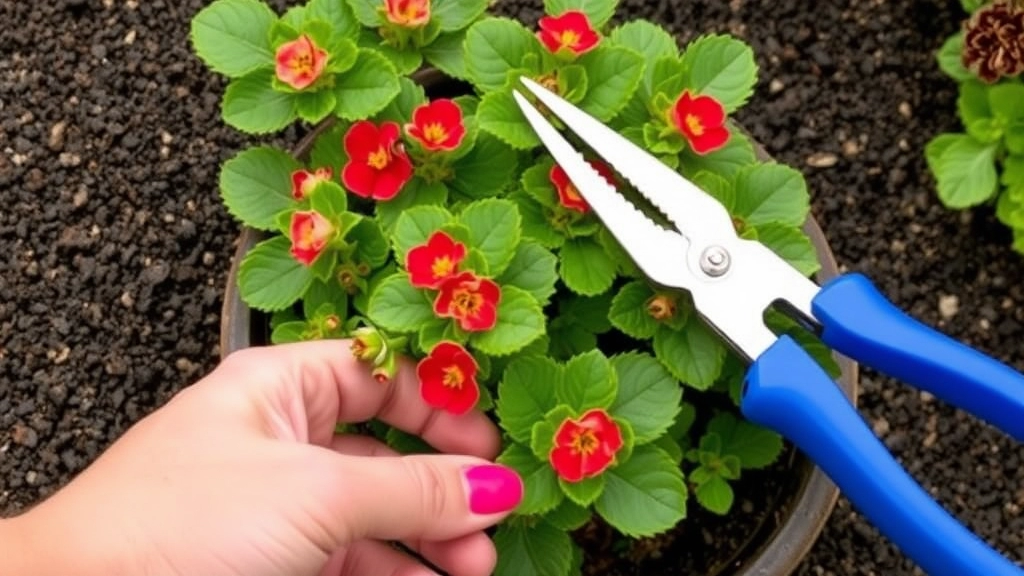
So, you’ve spotted those spent blooms on your Kalanchoe and you’re ready to take action. But wait! Before you dive into deadheading, let’s chat about the tools you’ll need.
Having the right tools makes all the difference. You don’t want to be fumbling around, right? Here’s what you should gather:
- Sharp Scissors or Pruners: A good pair of sharp scissors or pruning shears is essential. They’ll make clean cuts, reducing the risk of damaging the plant.
- Gloves: While Kalanchoe isn’t particularly prickly, wearing gloves can protect your hands from any sap or potential irritants.
- Small Container: Use a small bucket or bag to collect the dead blooms. This keeps your workspace tidy and makes cleanup a breeze.
- Watering Can: After deadheading, your plant might need a little hydration. Having your watering can handy is a smart move.
- Fertilizer: If you’re feeling fancy, a bit of balanced fertilizer can help your Kalanchoe bounce back after deadheading.
Having these tools ready will set you up for success.
Best Techniques for Deadheading Kalanchoe
When it comes to deadheading Kalanchoe, employing the right techniques can make a significant difference in the health and vibrancy of your plant. Many gardeners often worry about how to effectively remove spent blooms without causing harm. Here’s how to do it right:
- Use Clean Tools
Always start with clean, sharp scissors or pruning shears. This minimizes the risk of transmitting diseases to your plant. - Identify the Right Spot
Look for the spent blooms, which typically appear wilted or discoloured. - Cut Carefully
- Remove the Entire Flower Head: Aim to cut just above the first set of healthy leaves below the spent bloom. This encourages new growth.
- Avoid Leaving Stubs: Leaving behind stubs can lead to rot or disease.
- Take Your Time
Deadheading should be a deliberate process. Rushing may lead to accidental damage to healthy parts of the plant. - Observe Your Plant
While deadheading, take a moment to assess the overall health of your Kalanchoe. Look for any signs of pests or disease that may need addressing.
By following these techniques, you’ll help your Kalanchoe thrive and encourage more blooms. For more detailed care tips, check out our expert tips on caring for Kalanchoe succulents and our complete guide to Kalanchoe Mother of Thousands care and propagation.
Optimal Timing for Deadheading Kalanchoe
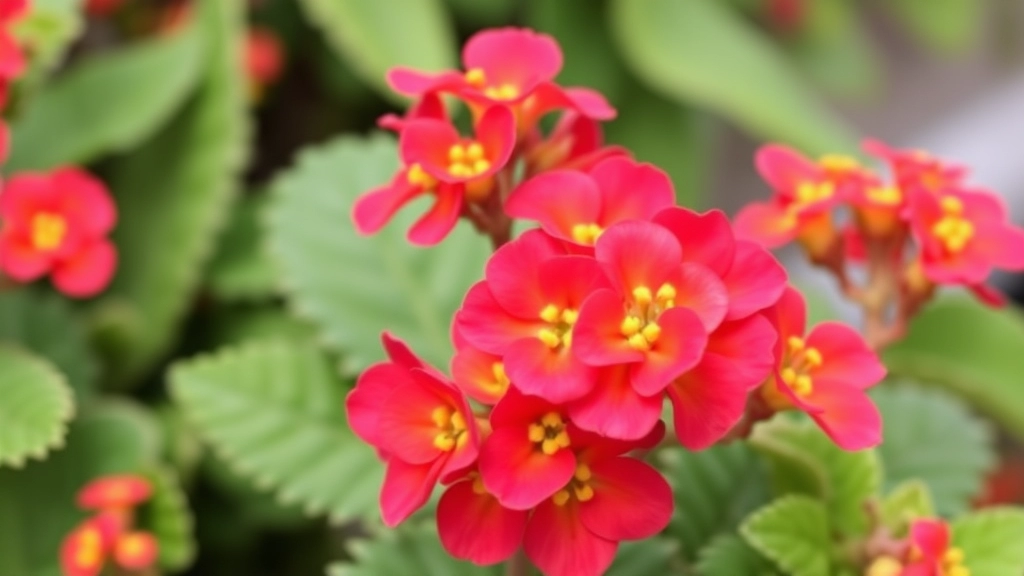
When should you deadhead your Kalanchoe? This question often haunts plant enthusiasts, especially when trying to maximise blooms. Timing is crucial in ensuring your plant thrives and continues to produce stunning flowers.
Key Timing Considerations:
- Post-Blooming Phase: The best time to deadhead is right after the flowers have wilted. This prevents the plant from putting energy into seed production.
- Seasonal Awareness: Kalanchoe typically blooms in late winter to early spring. Plan to deadhead shortly after the blooming period ends to encourage new growth.
- Regular Checks: Make it a habit to check your Kalanchoe every few weeks during the blooming season. This allows you to catch spent blooms before they affect the plant’s overall health.
- Weather Factors: If you experience particularly hot weather, consider deadheading sooner. Excess heat can stress the plant, making timely deadheading even more critical.
Avoiding Common Deadheading Mistakes
As we delve deeper into the care of Kalanchoe, it’s essential to be aware of common pitfalls that can hinder your plant’s recovery and blooming potential after deadheading.
- Cutting Too Much
One of the most frequent mistakes is removing too many leaves or stems.
– Always aim to cut only the spent blooms and a few inches of the stem.
– Avoid cutting into healthy foliage, as this can stress the plant. - Using Dull Tools
A common oversight is using blunt scissors or shears.
– Ensure your tools are sharp to make clean cuts.
– Clean tools prevent the spread of disease and promote quicker healing. - Ignoring Plant Health
Some gardeners overlook the overall health of their Kalanchoe before deadheading.
– Check for signs of pests or disease.
– If your plant is struggling, focus on its recovery before deadheading. - Timing Issues
Deadheading at the wrong time can affect blooming.
– Avoid deadheading during extreme weather conditions, such as intense heat or frost.
– Ideally, deadhead when the plant is actively growing. - Neglecting Aftercare
After deadheading, some may forget to provide proper post-care.
– Ensure your plant receives adequate water and sunlight.
– Consider applying a light fertiliser to encourage new growth.
For more detailed guidance, you might find our Kalanchoe care tips for thriving in Texas climate and complete guide to Kalanchoe paddle plant care useful.
Importance of Post-Deadheading Care
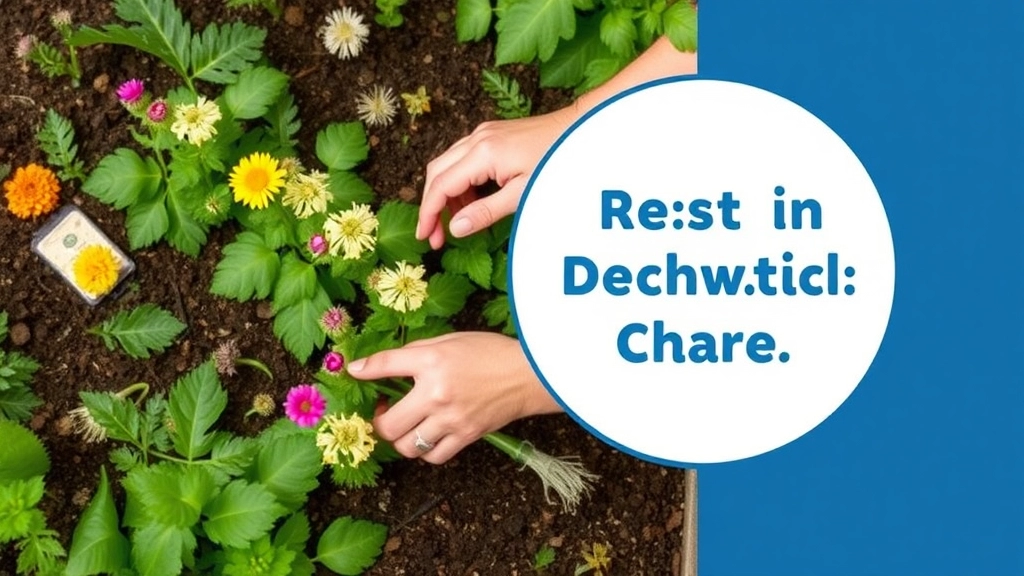
So, you’ve just deadheaded your Kalanchoe, and you might be wondering, “What’s next?”
Well, post-deadheading care is crucial to ensure your plant thrives and rewards you with fresh blooms.
Here’s what you should focus on:
- Watering: After deadheading, give your Kalanchoe a good drink. But don’t overdo it! Make sure the soil is well-draining. A little moisture goes a long way, especially after a trim.
- Fertilising: A light feed with a balanced fertiliser can really help. Look for something that’s high in potassium to boost blooming. Just follow the instructions on the package.
- Sunlight: Make sure your Kalanchoe gets plenty of bright, indirect light. This is key for encouraging new growth.
- Temperature: Keep your plant in a warm spot. Kalanchoes love warmth, so avoid cold drafts or sudden temperature changes.
- Pruning: Keep an eye out for any unhealthy leaves or stems. A little extra pruning can encourage more blooms and keep the plant looking tidy.
Remember, caring for your Kalanchoe after deadheading isn’t just about maintenance; it’s about nurturing.
Monitoring for New Growth and Blooms
After deadheading your Kalanchoe, you might wonder when to expect new growth and blooms. This period is crucial for ensuring your plant thrives and continues to flourish.
Handling and Disposal of Dead Blooms
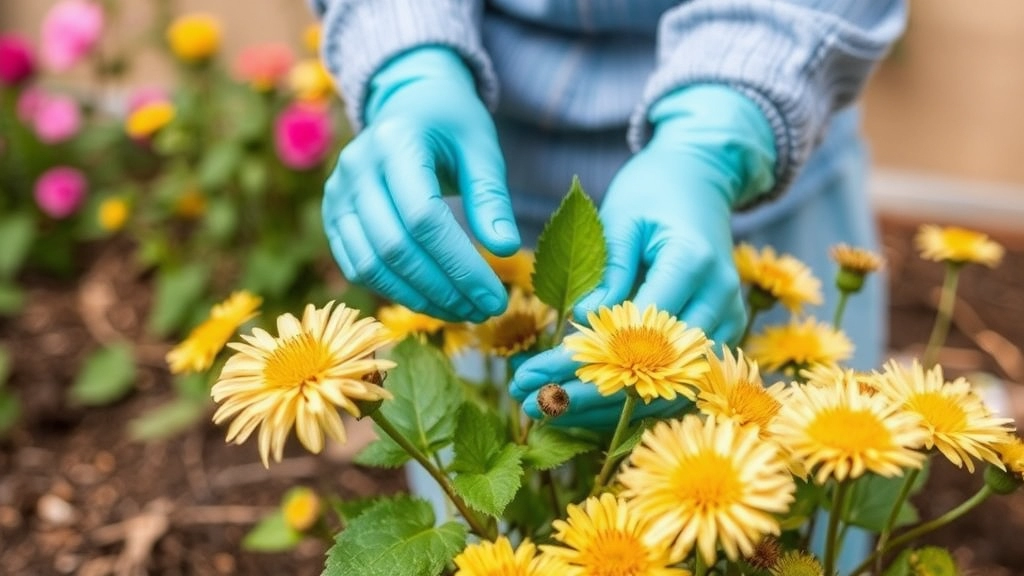
So, you’ve just deadheaded your Kalanchoe, and now you’re left with those spent blooms. What do you do with them? It’s a question many plant lovers ponder.
Why Proper Disposal Matters:
- Prevent Disease: Leaving dead blooms can attract pests or lead to mould.
- Aesthetics: Who wants a plant that looks messy?
- Encourage New Growth: Clearing away the old helps your Kalanchoe focus on producing fresh blooms.
Handling Dead Blooms:
- Use Gloves: Protect your hands from any potential irritants.
- Gently Remove: Pinch or snip the spent flowers at the base.
- Check for Pests: While you’re at it, keep an eye out for any unwanted guests hiding among the foliage.
Disposal Options:
- Composting: If your blooms are disease-free, toss them in your compost bin. They’ll break down and enrich your soil.
- Garden Waste Bin: If you suspect any issues, it’s best to dispose of them in your garden waste for safe measure.
- Household Trash: For a quick fix, just throw them away.
Troubleshooting: Why Your Kalanchoe May Not Bloom After Deadheading
After deadheading your Kalanchoe, you might find yourself eagerly awaiting new blooms, only to be met with disappointment.
FAQs on Deadheading Kalanchoe Flowers
What tools do I need for deadheading Kalanchoe flowers?
To effectively deadhead Kalanchoe flowers, you should have the following tools:
- Sharp Scissors or Pruners: Essential for making clean cuts.
- Gloves: To protect your hands from sap or potential irritants.
- Small Container: To collect the dead blooms and keep your workspace tidy.
- Watering Can: For hydrating the plant after deadheading.
- Fertilizer: For giving the plant a nutrient boost post-deadheading.
When is the best time to deadhead Kalanchoe flowers?
The optimal time to deadhead Kalanchoe flowers is:
- Post-Blooming Phase: Right after the flowers have wilted.
- Seasonal Awareness: Typically, Kalanchoe blooms in late winter to early spring, so plan to deadhead shortly after this period.
- Regular Checks: Check your plant every few weeks during the blooming season.
- Weather Factors: Deadhead sooner if experiencing particularly hot weather.
What should I do after deadheading my Kalanchoe?
Post-deadheading care is crucial. Here’s what you should focus on:
- Watering: Give your plant a good drink, but ensure the soil is well-draining.
- Fertilising: Use a balanced fertiliser high in potassium.
- Sunlight: Ensure the plant gets plenty of bright, indirect light.
- Temperature: Keep the plant in a warm spot, away from cold drafts.
- Pruning: Remove any unhealthy leaves or stems to encourage more blooms.
How should I handle and dispose of dead blooms?
Proper handling and disposal of dead blooms are important for several reasons:
Why Proper Disposal Matters:
- Prevent Disease: Avoid attracting pests or mould.
- Aesthetics: Maintain a tidy appearance.
- Encourage New Growth: Help the plant focus on producing fresh blooms.
Handling Dead Blooms:
- Use Gloves: Protect your hands from potential irritants.
- Gently Remove: Pinch or snip the spent flowers at the base.
- Check for Pests: Look for any unwanted guests hiding among the foliage.
Disposal Options:
- Composting: If disease-free, add them to your compost bin.
- Garden Waste Bin: Use this if you suspect any issues with the blooms.
- Household Trash: For a quick and easy disposal method.
References
-
How To Deadhead Kalanchoe Plants For More Blooms
-
Kalanchoe Plant Care and Growing Guide
-
Kalanchoe: How to Grow and Care for Kalanchoe Plants
